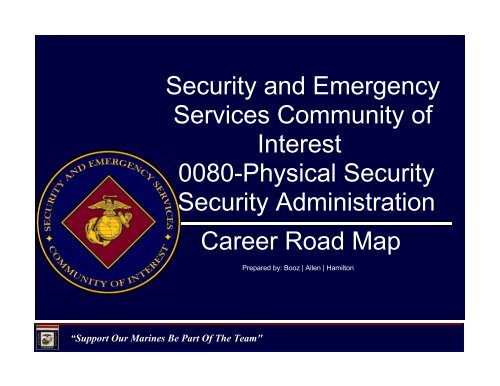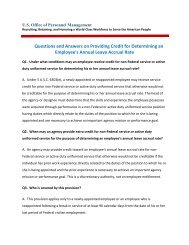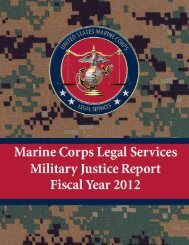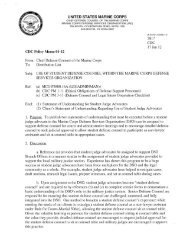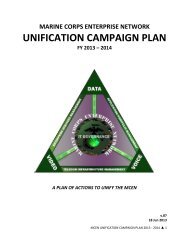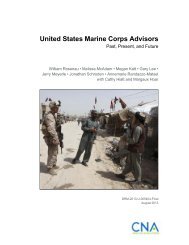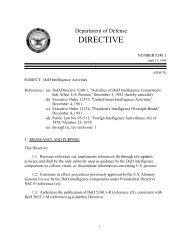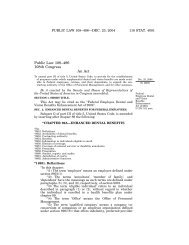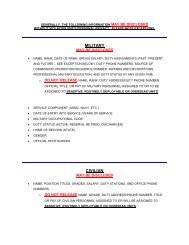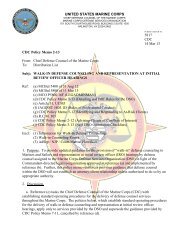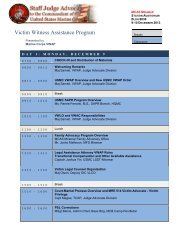Physical Security - Headquarters Marine Corps
Physical Security - Headquarters Marine Corps
Physical Security - Headquarters Marine Corps
You also want an ePaper? Increase the reach of your titles
YUMPU automatically turns print PDFs into web optimized ePapers that Google loves.
<strong>Security</strong> and Emergency<br />
Services Community of<br />
Interest<br />
0080-<strong>Physical</strong> <strong>Security</strong><br />
<strong>Security</strong> Administration<br />
Career Road Map<br />
Prepared by: Booz | Allen | Hamilton<br />
“Support Our <strong>Marine</strong>s Be Part Of The Team"
Career progression within the 0080-<strong>Physical</strong> <strong>Security</strong> Occupational Series is<br />
marked by advancing levels of expertise in matters of <strong>Security</strong> Administration<br />
“Support Our <strong>Marine</strong>s Be Part Of The Team" Page 2
Proficiency and Skill Band Definitions for 0080-<strong>Physical</strong> <strong>Security</strong><br />
The Proficiency Rating Scale below details the proficiency ratings and their corresponding definitions. Proficiency levels describe the levels<br />
of a competency required to perform a specific job successfully; these levels relate to the work required for a specific job. Different jobs require<br />
different levels of proficiency for successful performance.<br />
PROFICIENCY RATING<br />
PROFICIENCY<br />
0 N/A - Non Applicable/No Knowledge Necessary<br />
1 No Proficiency - Conceptual Knowledge Only/No Experience<br />
2 Low Proficiency -Able to Apply with Help<br />
3 Moderate Proficiency -Able to Apply Autonomously<br />
4 High Proficiency - Proficient/Able to Help Others<br />
5 Very High Proficiency - Expert Knowledge<br />
The Communities of Interest have outlined a career progress structure that more accurately reflects the change in your abilities and<br />
responsibilities over time. That structure is called the Skill Level Structure. It is associated with each Occupational Series and follows you from<br />
the time you are an entry-level employee until you reach management levels. Career progress in the USMC has traditionally been based on the<br />
Federal Government pay schedule system and the ranges within the pay schedule system are associated with the Skill Levels.<br />
JOB SKILL<br />
LEVEL<br />
SKILL BAND DEFINITION<br />
JOB SKILL LEVEL<br />
PAY PLAN<br />
BEGINNING GRADE<br />
TARGET<br />
GRADE<br />
1 Apprentice GS 4 7<br />
2 Journeyman GS 9 12<br />
3 Expert GS 13 15<br />
Behavioral Indicators: It is important to define how the competencies are manifested at different proficiency levels. In other words, what<br />
behaviors do incumbents in the Occupational Series demonstrate that indicate various levels of proficiency in each competency area. These<br />
demonstrations are referred to as behavioral indicators, and provide an objective description of the behavior that you might view in an individual<br />
that provides evidence that they either have or do not have the competency of interest. These are examples of what behaviors could look<br />
like and are not inclusive of all behaviors that demonstrate each level of performance for the competency. Rather, this is a tool to help guide<br />
evaluations of employee performance and should not be used as a checklist for employees’ behaviors.<br />
“Support Our <strong>Marine</strong>s Be Part Of The Team" Page 3
Desired Certifications, Academic Credentials and Training for 0080-<strong>Physical</strong><br />
<strong>Security</strong><br />
Level 1 Level 2 Level 3<br />
Army/FLETC/ASIS <strong>Physical</strong> <strong>Security</strong><br />
Certification<br />
Electronic Systems Administrator<br />
Certification<br />
National Crime Prevention Institute<br />
Crime Prevention Specialist<br />
Certification<br />
Desired Certifications<br />
Army/FLETC/ASIS <strong>Physical</strong> <strong>Security</strong><br />
Certification<br />
Army/FLETC/ASIS <strong>Physical</strong> <strong>Security</strong><br />
Certification<br />
Naval <strong>Security</strong> Manager’s Certification Naval <strong>Security</strong> Manager’s Certification<br />
National Crime Prevention Institute<br />
Crime Prevention Specialist<br />
Certification<br />
DoD Lock Specialist Certification<br />
Basic Antiterrorism II Certification<br />
US Army <strong>Corps</strong> of Engineers-<br />
Electronic <strong>Security</strong> Systems Design<br />
Certification<br />
Desired Academic Credentials<br />
National Crime Prevention Institute<br />
Crime Prevention Specialist<br />
Certification<br />
DoD Lock Specialist Certification<br />
Basic Antiterrorism II Certification<br />
US Army <strong>Corps</strong> of Engineers-<br />
Electronic <strong>Security</strong> Systems Design<br />
Certification<br />
High School Graduate Any BS/BA Degree Any BS/BA Degree<br />
Any AA/BS/BA Degree<br />
Desired Training<br />
DoD <strong>Security</strong> Engineering Planning<br />
and Standards<br />
Any MS/MA Degree<br />
DoD <strong>Security</strong> Engineering Planning<br />
and Standards<br />
*The courses found on this page and throughout this roadmap are recommended courses and may not be inclusive of all training<br />
available.<br />
“Support Our <strong>Marine</strong>s Be Part Of The Team" Page 4
Behavioral Indicators<br />
<strong>Physical</strong> <strong>Security</strong> Program Management<br />
DEFINITION<br />
Oversees and supports programs and implementation of protective measures that ensure mission accomplishment and enhance the security of<br />
installations/facilities and its contents in compliance with Department of Defense (DoD) and <strong>Marine</strong> <strong>Corps</strong> regulations, directives, and policies. Provides subject<br />
matter expertise to installations and commanders.<br />
Entry Intermediate Full Performance<br />
- Has a knowledge and understanding of the<br />
components and factors comprising the<br />
applicable physical security functional area (e.g.,<br />
CBRNE, CIP, Industrial <strong>Security</strong>, Antiterrorism,<br />
Crime Prevention, Flight Lines / Restricted Area,<br />
Arms, Ammunition, and Explosives (AA&E),<br />
Classified Information Storage Spaces, and<br />
Classified Materials <strong>Security</strong>)<br />
- Has a knowledge of security requirements in the<br />
applicable physical security functional area (e.g.,<br />
how to set physical security parameters)<br />
- Conducts inspections for compliance with<br />
physical security requirements<br />
- Reads and interprets blueprints and applies<br />
requirements<br />
- Integrates and coordinates physical security<br />
activities with those internal and external to the<br />
organization<br />
- Analyzes threats in the applicable physical security<br />
functional area<br />
- Implements and applies systems to mitigate threats<br />
to physical security<br />
- Interprets physical security requirements as they<br />
impact existing or planned work/activities<br />
- Reviews compliance inspections for accuracy and<br />
completeness before submission to command<br />
- Ensures organizational compliance with physical<br />
security requirements<br />
- Determines whether infrastructure will support<br />
certain technologies<br />
- Ensures security requirements are in compliance<br />
with applicable orders and directives<br />
- Reviews blueprints and applies requirements<br />
- Develops and provides mitigating requirements in<br />
case of non-compliance<br />
- Assists in submission of exception/waiver requests<br />
- Provides <strong>Marine</strong> <strong>Corps</strong> leadership with requisite<br />
knowledge to make informed security decisions<br />
- Writes physical security plans, policies, and<br />
procedures<br />
- Mentors and educates less experienced staff on<br />
compliance inspection criteria, protocols, and<br />
procedures<br />
- Builds awareness of emerging physical security<br />
technologies and requirements<br />
- Formulates strategic plans and the future vision of<br />
the physical security program<br />
- Ensures compliance of large-scale projects with<br />
applicable orders and directives<br />
- Establishes and submits budgets<br />
- Develops and provides mitigating requirements in<br />
case of non-compliance<br />
- Assists in submission of exception/waiver requests<br />
“Support Our <strong>Marine</strong>s Be Part Of The Team" Page 5
Competency-Based Training Opportunites<br />
<strong>Physical</strong> <strong>Security</strong> Program Management<br />
Skill<br />
Proficiency<br />
Level<br />
Min<br />
Max<br />
1 1 2<br />
2 3 4<br />
DEFINITION<br />
Oversees and supports programs and implementation of protective measures that ensure mission accomplishment and enhance the security<br />
of installations/facilities and its contents in compliance with Department of Defense (DoD) and <strong>Marine</strong> <strong>Corps</strong> regulations, directives, and<br />
policies. Provides subject matter expertise to installations and commanders.<br />
3 4 5<br />
Course Skill Level Institution<br />
Antiterrorism Force Protection (ATFP) Workshop 1,2,3 NAVAC ESC<br />
Basic CPTED (Crime Prevention Through Environmental Design) 1,2,3 NCPI<br />
Basic Crime Prevention Certification Seminar 1,2,3 ACPI<br />
Basic Crime Prevention Through Environmental Design (CPTED) Seminar 1,2,3 ACPI<br />
Comprehensive <strong>Security</strong> Specialist 1,2,3 LSI<br />
Comprehensive <strong>Security</strong> Specialist 2,3 LSI<br />
DCID 6/9 <strong>Physical</strong> <strong>Security</strong> Seminar 2,3 DSSA<br />
Introduction to <strong>Physical</strong> <strong>Security</strong> Course 1,2 DSSA<br />
Lighting Technology 1,2,3 Lighting Education Online<br />
Lighting Terminology 1,2,3 Lighting Education Online<br />
<strong>Physical</strong> <strong>Security</strong> Professional (PSP) Development Course 2,3 ASIS International<br />
<strong>Physical</strong> <strong>Security</strong> Training Program (PSTP) 2,3 FLETC<br />
Residential Lighting 1,2,3 Lighting Education Online<br />
“Support Our <strong>Marine</strong>s Be Part Of The Team" Page 6
Behavioral Indicators<br />
Electronic <strong>Security</strong> Systems Management<br />
DEFINITION<br />
Ensures effective operation and maintenance of electronic security systems. Identifies electronic security requirements, oversees system installation, conducts<br />
compliance inspections, and proposes electronic security solutions. Safeguards installation assets through the use of electronic security systems. Demonstrates<br />
knowledge of emerging technology areas (e.g., biometrics, surveillance, access control, CCTV, intrusion detection, radar, encryption, CBRNE detection, etc.).<br />
Entry Intermediate Full Performance<br />
- Has a knowledge of security requirements in<br />
applicable electronic security functional areas<br />
(e.g., how to set physical security parameters)<br />
- Conducts inspections for compliance with<br />
electronic security requirements with close<br />
supervision<br />
- Records and submits electronic security system<br />
issues for repair/resolution<br />
- Operates basic security systems<br />
- Awareness of emerging security technology<br />
areas (e.g., attending conferences/symposiums)<br />
- Conducts Media research to understand state of<br />
the market, existing technologies<br />
- Understands security requirements as it relates<br />
to technologies<br />
- Understands minimum protection requirements<br />
for ESS<br />
- Tests operational status of ESS<br />
- Conducts inspections for compliance with electronic<br />
security requirements<br />
- Submits requests for installation of new and<br />
upgrades to existing electronic security systems<br />
- Performs diagnostics, conducts basic maintenance<br />
on, and submits requests for repair/resolution of<br />
electronic security system<br />
- Identifies electronic security requirements<br />
- Trains electronic security system operators on<br />
system problem identification and response<br />
- Prepares and presents emerging technologies at<br />
conferences/symposiums<br />
- Identifies deficiencies in existing technologies<br />
- Evaluates effectiveness of existing technologies and<br />
upgrades<br />
- Understands systems integration<br />
- Tests operational status of ESS<br />
= Prepares and submits budget<br />
- Evaluates system integration<br />
- Coordinates/manages submission of requests for<br />
installation of new and upgrades to existing electronic<br />
security systems<br />
- Validates electronic security requirements<br />
- Identifies and evaluates electronic security solutions<br />
to determine effectiveness and feasibility<br />
- Proposes new electronic security technologies for<br />
consideration by <strong>Headquarters</strong><br />
- Performs electronic security system issue trend<br />
analysis and problem resolution<br />
- Organizes and speaks at emerging technologies<br />
conferences/symposiums<br />
- Provides recommendations for the evaluation and<br />
applicability of new technologies<br />
- Provides input and guidance to the development of<br />
new technologies<br />
- Identifies threats vulnerabilities of new technology<br />
- Integrates security technology capabilities in<br />
security program<br />
- Reviews, approves, and forwards budget submission<br />
“Support Our <strong>Marine</strong>s Be Part Of The Team" Page 7
Competency-Based Training Opportunites<br />
Electronic <strong>Security</strong> Systems Management<br />
Skill<br />
Proficiency<br />
Level<br />
Min<br />
Max<br />
1 1 2<br />
2 3 4<br />
3 4 5<br />
DEFINITION<br />
Ensures effective operation and maintenance of electronic security systems. Identifies electronic security requirements, oversees system<br />
installation, conducts compliance inspections, and proposes electronic security solutions. Safeguards installation assets through the use of<br />
electronic security systems. Demonstrates knowledge of emerging technology areas (e.g., biometrics, surveillance, access control, CCTV,<br />
intrusion detection, radar, encryption, CBRNE detection, etc.).<br />
Course Skill Level Institution<br />
DCID 6/9 <strong>Physical</strong> <strong>Security</strong> Seminar 2,3 DSSA<br />
Electronic <strong>Security</strong> Systems Administrators Course 1,2,3 SPAWAR<br />
Electronic <strong>Security</strong> Systems Design Course 1,2,3 USACE PDC<br />
“Support Our <strong>Marine</strong>s Be Part Of The Team" Page 8
Behavioral Indicators<br />
Access Control<br />
DEFINITION<br />
Controls access and prevents unauthorized access to personnel, equipment, material, documents, and safeguards against espionage, sabotage, acts of terrorism,<br />
damage, and theft.<br />
Entry Intermediate Full Performance<br />
- Understands the concepts related to denial of<br />
access to restricted facilities<br />
- Understands and operates barrier systems to<br />
control vehicular and personnel movement<br />
- Determines whether the physical safeguarding<br />
requirements for restricted areas are met<br />
- Understands and implements signage<br />
requirements for restricted areas<br />
- Applies policy requirements to facilities/areas<br />
- Inspects equipment<br />
- Identifies various options for equipment<br />
- Determines the physical safeguarding requirements<br />
for restricted areas<br />
- Designs and maintains security accountability,<br />
control methods, and tools<br />
- Responsible for the inspection and oversight of<br />
access control procedures<br />
- Implements and maintains specialized access<br />
control programs for restricted areas (e.g., classified<br />
material storage, COMSEC, Flight Lines)<br />
- Assists in the conduct of preliminary inquiries into<br />
physical and electronic security violations<br />
- Trains personnel in systems operations<br />
- Identifies various options for equipment<br />
- Develops barrier plan<br />
- Reviews new technology<br />
- Makes recommendations to Commander regarding<br />
issues of access control regarding security posture<br />
- Ensures that appropriate restriction level standards<br />
are maintained<br />
- Implements new physical and electronic security<br />
policies<br />
- Mentors and educates less experienced staff or<br />
external personnel on security regulations, directives,<br />
and policies<br />
- Recommends courses of action for remediation,<br />
mitigation, or correction of security violations<br />
- Approves barrier plan<br />
- Evaluates and approves systems integration<br />
“Support Our <strong>Marine</strong>s Be Part Of The Team" Page 9
Competency-Based Training Opportunites<br />
Access Control<br />
Skill<br />
Proficiency<br />
Level<br />
Min<br />
Max<br />
1 1 2<br />
2 3 4<br />
DEFINITION<br />
Controls access and prevents unauthorized access to personnel, equipment, material, documents, and safeguards against espionage,<br />
sabotage, acts of terrorism, damage, and theft.<br />
3 4 5<br />
Course Skill Level Institution<br />
Access Control Point Training 2,3 USACE PDC<br />
Access Control Technician (ACT) 2,3 LSI<br />
Comprehensive <strong>Security</strong> Specialist 1,2,3 LSI<br />
Comprehensive <strong>Security</strong> Specialist 2,3 LSI<br />
DCID 6/9 <strong>Physical</strong> <strong>Security</strong> Seminar 2,3 DSSA<br />
Lock and Key Systems Course 1,2,3 DSSA<br />
<strong>Physical</strong> <strong>Security</strong> Measures Course 1,2 DSSA<br />
SDDCTEA 1,2,3 SDDCTEA<br />
“Support Our <strong>Marine</strong>s Be Part Of The Team" Page 10
Behavioral Indicators<br />
<strong>Security</strong> Awareness, Education, & Training<br />
DEFINITION<br />
Provides for the development, execution, and evaluation of educational programs (such as Welcome Aboard Briefs) to ensure security awareness, education, and<br />
training.<br />
Entry Intermediate Full Performance<br />
- Knowledge of principles, practices, policies, and<br />
techniques of training, education, and employee<br />
development<br />
- Possesses a broad understanding of overall<br />
security programs and policies<br />
- Comprehends concepts and intended purpose<br />
of security requirements (e.g., accountability and<br />
control standards, threat conditions)<br />
- Communicates security requirements with<br />
minimal guidance<br />
- Understands organizational mission<br />
requirements and the relationship with security<br />
- Prepares training materials (e.g., presentations,<br />
guides)<br />
- Prepares media presentations for dissemination<br />
- Delivers training and education on security<br />
requirements relevant to the mission of the<br />
organization<br />
- Identifies deficiencies in security training, education,<br />
and awareness (e.g., violation evaluation, surveys,<br />
trend analysis)<br />
- Designs training materials (e.g., presentations,<br />
guides) in alignment with performance and learning<br />
objectives<br />
- Approves media presentations<br />
- Develops security requirements training, education,<br />
and outreach programs<br />
- Evaluates security training, education, and<br />
awareness deficiencies and develops<br />
programs/initiatives to address gaps<br />
- Educates leadership on the value added of security<br />
training, education, and awareness programs<br />
- Identifies training, education, and awareness<br />
resources<br />
- Advocates senior leadership buy-in to security<br />
awareness, education, and training programs<br />
- Uses innovative technologies to facilitate the<br />
development and delivery of training, education, and<br />
awareness programs<br />
“Support Our <strong>Marine</strong>s Be Part Of The Team" Page 11
Competency-Based Training Opportunites<br />
<strong>Security</strong> Awareness, Education, & Training<br />
Skill<br />
Proficiency<br />
Level<br />
Min<br />
Max<br />
1 1 2<br />
2 3 4<br />
DEFINITION<br />
Provides for the development, execution, and evaluation of educational programs (such as Welcome Aboard Briefs) to ensure security<br />
awareness, education, and training.<br />
3 4 5<br />
Course Skill Level Institution<br />
Conventional <strong>Physical</strong> <strong>Security</strong> Course 1,2,3 USAMP FPTD<br />
Crime Prevention and Introduction to <strong>Physical</strong> <strong>Security</strong> 1,2 NCPI<br />
DoD <strong>Security</strong> Engineering Planning and Standards 2,3 USACE PDC<br />
<strong>Security</strong> Engineering 2,3 USACE PDC<br />
“Support Our <strong>Marine</strong>s Be Part Of The Team" Page 12
Behavioral Indicators<br />
Acquisition Management<br />
DEFINITION<br />
Uses Knowledge of acquisition management functions, practices, and policies, and an understanding of how these functions contribute to the accomplishment of<br />
the organization's mission.<br />
Entry Intermediate Full Performance<br />
- Knowledge of Defense Federal Acquisition<br />
Regulations (DFAR) and general acquisition and<br />
contracting principles<br />
- Awareness of the acquisition process and the<br />
relationship between industry and government<br />
- Understands basic acquisition rules (e.g.,<br />
obligation of government funds)<br />
- Understands MARCORSYSCOM’s authority and<br />
role in the acquisition/contracting process<br />
- Understands sources of funding (e.g., MILCON,<br />
PSUP funds, etc.) and how they are aligned with<br />
various project types<br />
- Understands security restrictions and prohibitions<br />
as it relates to acquisitions, contracts, and the<br />
performance of work<br />
- Evaluates and provides feedback on physical<br />
security-related outputs of contracts as part of a<br />
larger program<br />
- Understands sources of funding (e.g., MILCON,<br />
PSUP funds, etc.) and how they are aligned with<br />
various project types<br />
- Defines operational requirements and identifies the<br />
need for acquisition and contracting activities to meet<br />
requirements<br />
- Develops technical requirements for Statements of<br />
Work (SOWs) in collaboration with contracting and<br />
procurement personnel<br />
- Manages contractual agreements to ensure quality<br />
standards are met and kept<br />
- Manages acquisitions and contracts for programs in<br />
support of mission objectives<br />
- Provides physical security input to source selection<br />
board as part of a larger program<br />
“Support Our <strong>Marine</strong>s Be Part Of The Team" Page 13
Competency-Based Training Opportunites<br />
Acquisition Management<br />
Skill<br />
Proficiency<br />
Level<br />
Min<br />
Max<br />
1 1 2<br />
2 3 4<br />
DEFINITION<br />
Uses Knowledge of acquisition management functions, practices, and policies, and an understanding of how these functions contribute to the<br />
accomplishment of the organization's mission.<br />
3 4 5<br />
Course Skill Level Institution<br />
ACQ 101 Fundamentals of Systems Acquisition Management 1,2 DAU<br />
ACQ 201A Intermediate Systems Acquisition, Part A 2,3 DAU<br />
ACQ 201B Intermediate Systems Acquisition, Part B 2,3 DAU<br />
ACQ 451 Integrated Acquisition for Decision Makers 3 DAU<br />
ACQ 452 Forging Stakeholder Relationships 3 DAU<br />
“Support Our <strong>Marine</strong>s Be Part Of The Team" Page 14
Behavioral Indicators<br />
Risk Management<br />
DEFINITION<br />
Identifies critical assets, threats and vulnerabilities, and mitigation strategies to arrive at an acceptable level of risk throughout a physical security program along<br />
with recording, maintaining, and reporting various risk management activities.<br />
Entry Intermediate Full Performance<br />
- Understands risk management process,<br />
principles, concepts, and application<br />
- Participates and assists in the risk management<br />
process<br />
- Participates in the identification of critical assets<br />
- Applies risk management process, principles, and<br />
concepts<br />
- Participates in the analysis, evaluation,<br />
development, coordination, and dissemination of risk<br />
management methods and tools<br />
- Defines and analyzes risk management,<br />
assessment, and mitigation procedures in<br />
accordance with organizational goals<br />
- Develops and recommends risk management<br />
courses of action to senior leadership<br />
- Develops specific risk management policies and<br />
procedures; considers risk as a basis for every policy<br />
decision that is made<br />
- Participates in cross-functional risk management<br />
planning with other security disciplines (e.g.,<br />
Information, Personnel)<br />
“Support Our <strong>Marine</strong>s Be Part Of The Team" Page 15
Competency-Based Training Opportunites<br />
Risk Management<br />
Skill<br />
Proficiency<br />
Level<br />
Min<br />
Max<br />
1 1 2<br />
2 3 4<br />
DEFINITION<br />
Identifies critical assets, threats and vulnerabilities, and mitigation strategies to arrive at an acceptable level of risk throughout a physical<br />
security program along with recording, maintaining, and reporting various risk management activities.<br />
3 4 5<br />
Course Skill Level Institution<br />
GSA Certified Safe and Vault Technician with GSA Approved Inspector Option 2,3 MBA USA, INC.<br />
<strong>Physical</strong> <strong>Security</strong> Measures Course 1,2 DSSA<br />
Risk Management for DoD <strong>Security</strong> Programs Course 2,3 DSSA<br />
“Support Our <strong>Marine</strong>s Be Part Of The Team" Page 16
<strong>Security</strong> Emergency Services Internal Community Career Path<br />
“Support Our <strong>Marine</strong>s Be Part Of The Team" Page 17
Acronyms Defined<br />
Acronym<br />
Acronym Defined<br />
ACPI<br />
DAU<br />
DSSA<br />
FLETC<br />
LSI<br />
MBA USA, INC.<br />
NAVAC ESC<br />
NCPI<br />
SDDCTEA<br />
SPAWAR<br />
USACE PDC<br />
American Crime Prevention Institute<br />
Defense Acquisition University<br />
Defense <strong>Security</strong> Service Academy<br />
Federal Law Enforcement Training Center<br />
Laboratory for Scientific Interrogation<br />
MBA USA, INC.<br />
Naval Facilities Engineering Command Engineering Service Center (NAVAC ESC)<br />
National Crime Prevention Institute<br />
Surface Deployment and Distribution Command Transportation Engineering Agency (SDDCTEA)<br />
Space and Naval Warfare Systems Command<br />
United States Army <strong>Corps</strong> of Engineers Protective Design Center (USACE PDC)<br />
USAMP FPTD<br />
United States Army Military Police School, Force Protection Training Division<br />
*For additional courses supporting the following behavioral competencies: Communication, Leadership, Self Management and Planning, Decision Making Problem Solving, Teamwork, and<br />
Health Safety please refer to the Civilian leadership Developent (CLD Course Catalog. This catalog can be found on this website:<br />
https://www.manpower.usmc.mil/pls/portal/docs/PAGE/M_RA_HOME/MP/MPC/CWM/TRAININGRESOURCES/CIVILIAN%20LEADERSHIP%20COURSE%20CATALOG/MP_MPC_TR_C<br />
LCC_REF/FULL%20COURSE%20CATALOG.PDF<br />
“Support Our <strong>Marine</strong>s Be Part Of The Team" Page 18


